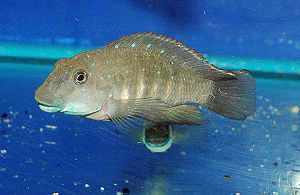Eretmodus cyanostictus
| Eretmodus cyanostictus | ||||||||||||
|---|---|---|---|---|---|---|---|---|---|---|---|---|

Eretmodus cyanostictus |
||||||||||||
| Systematics | ||||||||||||
|
||||||||||||
| Scientific name | ||||||||||||
| Eretmodus cyanostictus | ||||||||||||
| Boulenger , 1898 |
Eretmodus cyanostictus , also known as Tanganyika clown or striped goby cichlid in German, is aspecies of cichlid that lives endemically on the coasts of the East African Lake Tanganyika . The scientific type epithet refers to the bluish iridescent points in the head region ( Gr .: "kyaneos" = blue, "stigma" = mark, sign).
features
Females of Eretmodus cyanostictus become 8 cm long, males with 9 to 10 cm a little longer. The body is elongated, somewhat flattened on the sides and only a little high. The head is massive and large, the mouth below. Each jaw is set with spatulate teeth that are arranged in two to three rows. The dorsal fin is long and pointed at the soft end. The pelvic and anal fins are also pointed. The swim bladder is short. Eretmodus cyanostictus has a gray, olive green, dark brown to beige-brownish base color and, depending on the geographical variant, has a different dot or stripe pattern on the body, head and fins. The bottom of the head and lips are usually blue. The animals from the north and the middle of Lake Tanganyika have 7 to 9 vertical yellowish to orange stripes on the sides of the body. In fish from the southern part of the lake, this pattern is reduced to 5 to 6 stripes that adorn the lower half of the body. On the top of the fuselage they show 2 to 3 rows of blue dots. The dorsal fin is lined with orange, the ventral fin is transparent, all other fins are brownish.
- Fin formula : Dorsal XXIII – XXV / 3–5, Anale III / 6–7
- Dandruff formula mLR 32–35, SL 22–23 / 6–9
Way of life
Eretmodus cyanostictus lives close to the coast at depths of up to ten meters in very oxygen-rich water and forms territory . It feeds on algae growth on stones and the micro and small organisms they contain. The cichlids spawn on a flat stone surface or over a sandy bottom. Then the approximately 20 to 30 eggs are taken into the mouth by the female for approximately 12 to 14 days. Then the mouthbrood care is passed on to the male , who carries the eggs around in his mouth for another 7 to 10 days. Once the juvenile fish have hatched, they are released from the mouth, cared for in pits in the lake floor and not taken back into the mouth.
literature
- Hans Joachim Richter: Zwergbuntbarsche Neumann Verlag, Leipzig, Radebeul, ISBN 3-7402-0028-6 .
- Georg Zurlo: Eretmodus cyanostictus. In: Claus Schaefer, Torsten Schröer (Hrsg.): The large lexicon of aquaristics. Eugen Ulmer, Stuttgart 2004, ISBN 3-8001-7497-9 , p. 365.
- Günther Sterba : The world's freshwater fish. 2nd Edition. Urania, Leipzig / Jena / Berlin 1990, ISBN 3-332-00109-4 .
- Günther Sterba (Ed.), Gert Brückner: Encyclopedia of Aquaristics and Special Ichthyology. Neumann-Neudamm, Melsungen u. a. 1978, ISBN 3-7888-0252-9 .
Web links
- Eretmodus cyanostictus on Fishbase.org (English)
- Eretmodus cyanostictus in the Red List of Threatened Species of the IUCN 2013.2. Posted by: Bigirimana, C., 2006. Retrieved February 8, 2014.